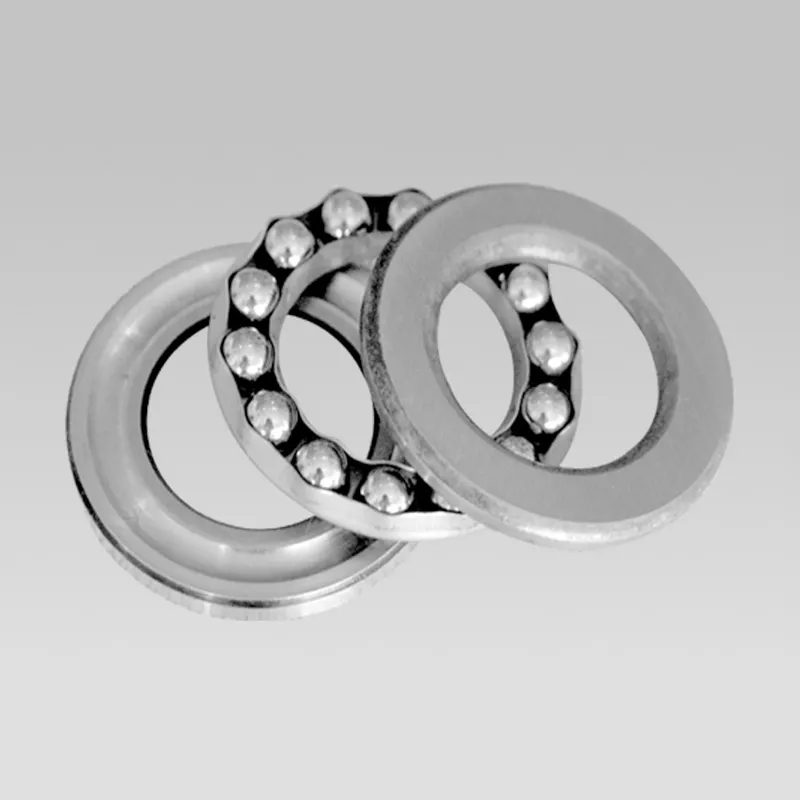
Mar . 12, 2025 14:25 Atpakaļ uz sarakstu
Vilces lodīšu gultņi
In modern industrial applications, thrust ball bearings play a crucial role in ensuring smooth and efficient machine operation. These bearings are specifically designed to handle axial loads while providing stability and reducing friction. Unlike radial bearings, which support rotational movement in all directions, thrust ball bearings primarily handle forces along a single axis, making them essential for applications like automotive transmissions, aerospace engineering, and heavy-duty machinery.

The unique construction of thrust ball bearings includes a set of steel balls positioned between two raceways, allowing them to accommodate high-speed operations with minimal wear. Whether used in industrial gear systems, railway applications, or marine propulsion, these bearings ensure durability and performance in demanding conditions. Their ability to support axial loads in one or both directions makes them indispensable in industries requiring precise motion control and heavy-duty support.
Understanding What Is the Thrust Bearing and Its Importance in Engineering
For those unfamiliar with industrial components, a common question is, what is the thrust bearing, and how does it differ from other types of bearings? A thrust bearing is a mechanical component designed to support axial loads while allowing smooth rotational movement. Unlike traditional ball or roller bearings, which manage radial loads, thrust bearings are engineered specifically for applications where forces are directed along a singular axis.
When asking what is the thrust bearing, it's essential to recognize its versatility. These bearings come in various designs, including thrust ball bearings, cylindrical thrust bearings, and tapered thrust bearings. Each type is tailored for specific applications, ensuring efficiency and longevity in different industrial settings. Whether in automotive clutches, wind turbines, or heavy machinery, thrust bearings provide exceptional performance by reducing friction and wear while supporting high-load applications.
The Strength and Stability of Conical Thrust Bearing in Heavy-Duty Applications
For applications requiring superior load distribution, the conical thrust bearing stands out as a reliable choice. Unlike traditional flat thrust bearings, conical thrust bearings feature tapered rolling elements, allowing them to handle higher axial loads while offering greater stability and reduced friction. This makes them ideal for use in automotive differentials, industrial transmissions, and railway axles.
One of the key advantages of a conical thrust bearing is its ability to accommodate misalignment while maintaining high efficiency. Its tapered design enables even load distribution, reducing wear and extending operational life. Additionally, conical thrust bearings excel in applications where combined axial and radial forces need to be managed efficiently, ensuring smooth machine operation even under extreme conditions.
The Versatility of Spherical Thrust Bearings in High-Load Applications
Another essential bearing type for heavy-duty industries is the spherical thrust bearing. Designed with a spherical rolling element, these bearings can handle axial loads while compensating for misalignment. The self-aligning feature of spherical thrust bearings makes them particularly useful in applications such as hydraulic turbines, offshore drilling rigs, and metalworking machinery.
The advanced design of spherical thrust bearings allows them to operate efficiently in high-speed environments while reducing heat generation. Their ability to withstand high loads and absorb shock loads ensures longer service life and minimal maintenance requirements. Industries that require continuous, high-performance operation rely on spherical thrust bearings to maintain smooth motion and enhance machine efficiency.
Maximizing Performance with the Right Vilces lodīšu gultņi Selection
Selecting the right thrust ball bearings is crucial for achieving optimal machine performance and durability. Factors such as load type, operating speed, and environmental conditions must be considered when choosing the correct bearing type. Whether you need conical thrust bearings for heavy machinery or spherical thrust bearings for misalignment compensation, investing in high-quality bearings ensures long-term reliability and cost efficiency.
By understanding what is the thrust bearing and how different types function, industries can make informed decisions when selecting bearings for specific applications. With advancements in bearing technology, thrust ball bearings continue to play a vital role in improving efficiency, reducing downtime, and extending the lifespan of industrial equipment.
